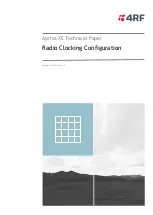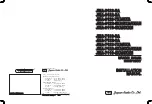
13
BE 58-602 Pulsar
®
Model R96 Radar Transmitter
2.3
Before You Begin
2.3.1 Site Preparation
Each PULSAR Model R96 Radar transmitter/antenna is
built to match the physical specifications of the required
installation. Ensure that the probe process connection is
correct for the threaded or flanged mounting on the vessel
where the transmitter will be placed. See Mounting,
Section 2.4.
Ensure that all local, state, and federal regulations and
guidelines are observed. See Wiring, Section 2.5.
Ensure that the wiring between the power supply and
PULSAR Model R96 Radar transmitter is complete and
correct for the type of installation. See Specifications,
Section 3.7.
2.3.2 Equipment and Tools
No special tools are needed. The following items are
recommended:
• Threaded antenna and process connection . . . . 2" (50 mm)
• Transmitter/antenna connection . . 1 3/4" (44 mm) wrench
• Transmitter adjustment . . . . . . . . . 1 1/8" (28 mm) wrench
. . . . . . . . . . . . . . . . . . . . . . . . . . . . . . 3/32" Hex wrench
• Torque wrench . . . . . . . . . . . . . . . . . . . . . . highly desirable
• Flat-blade screwdriver
• Digital multimeter or volt/ammeter . . . . . . . . . . . Optional
• 24 VDC (23 mA) power supply . . . . . . . . . . . . . . Optional
2.3.3 Operational Considerations
Radar applications are characterized by three basic conditions;
Dielectric (process medium), Distance (measuring range)
and Disturbances (turbulence, foam, false targets, multiple
reflections and rate of change). The PULSAR Model R96
Radar transmitter is offered with two antenna configura-
tions—Horn and Dielectric Rod. Ideally, the 6" Horn
antenna should be used to ensure the best possible perform-
ance in all operational conditions.
2.3.3.1 Maximum Distance
The chart on the following page shows the maximum meas-
uring range (Distance) of each antenna based on fundamental
conditions of Dielectric, Distance and Turbulence. Distance
is measured from the Sensor Reference Point (bottom of
NPT thread, top of BSP thread or face of a flange).














































